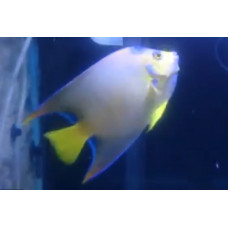Latin name
Holacanthus ciliaris
Other names
French: demoiselle royale; Spanish: isabelita patale.
Identification
The king angelfish has a moderately large body, deep and compressed. The most notable thing about the appearance of the royal angelfish is its coloration. It is mottled, yellowish-orange, and blue. The amount of blue varies from individual to individual and varies in intensity. She has a bright blue fringe on her soft dorsal and anal fins, her fin tips are colored orange, and her last rays are bluish black. She also has a yellowish-orange tail and a dark bluish-black spot on her forehead, ringed in bright blue, which forms the queen's "crown". The coloration of the young queen angelfish is dark blue. The body has curved bluish-white stripes. Caribbean angel fish are usually brighter than those off the coast of North and South America.
Distribution
Angel queens are found in Florida, the Bahamas, and the Caribbean; they are found in Bermuda, the Gulf of Mexico, and as far south as Brazil, as well as on coral reefs in the West Indies.
Habitat
The angelfish queen lives on coral reefs in shallow water. Juveniles prefer offshore reefs, and adult fish are found at depths of 20 to 80 feet. They are often indistinguishable from the colorful corals among which they swim.
Size
King angelfish are no longer than 18 inches long and average between 8 and 14 inches. According to some reports, they reach a length of almost 2 feet.
Life history and Behavior
The angelfish queen is usually found alone or in pairs. Not a gregarious fish.
Food and feeding habits
Adults feed mainly on sponges, but also consume algae and tiny organisms.
Reproduction
No information
| Classification | |
| Phylum | Chordata |
| Class | Actinopterygii |
| Family | Pomacanthidae |
| Genus | Holacanthus |
| Species | H. ciliaris |
| Features | |
| Conservation status | Least Concern |
| Habitat | Littoral |
| Life span, years | 15 |
| Maximum body weight, kg | 0.91 |
| Maximum length, cm | 30 |
| Sailing speed, m/s | No information |
| Threat to people | Edible |
| Way of eating | Planktonophage |


